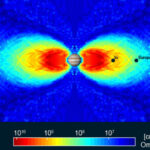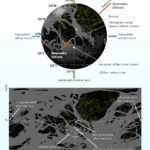First hypothesized more than 60 years ago, the ambipolar electric field is a key driver of the polar wind, a steady outflow of charged particles into space that occurs above Earth’s poles. This electric field lifts charged particles in our upper atmosphere to greater heights than they would otherwise reach and may have shaped our planet’s evolution in ways yet to be explored.
Collinson et al. report the existence of a +0.55 ± 0.09 V electric potential drop between 250 km and 768 km from a planetary electrostatic field generated exclusively by the outward pressure of ionospheric electrons; they experimentally demonstrate that the ambipolar field of Earth controls the structure of the polar ionosphere, boosting the scale height by 271%. Image credit: NASA.
Since the 1960s, spacecraft flying over Earth’s poles have detected a stream of particles flowing from our atmosphere into space.
Theorists predicted this outflow, which they dubbed the polar wind, spurring research to understand its causes.
Some amount of outflow from our atmosphere was expected. Intense, unfiltered sunlight should cause some particles from our air to escape into space, like steam evaporating from a pot of water. But the observed polar wind was more mysterious.
Many particles within it were cold, with no signs they had been heated — yet they were traveling at supersonic speeds.
“Something had to be drawing these particles out of the atmosphere,” said Endurance principal investigator Dr. Glyn Collinson, a researcher at NASA’s Goddard Space Flight Center.
The hypothesized electric field, generated at the subatomic scale, was expected to be incredibly weak, with its effects felt only over hundreds of miles.
For decades, detecting it was beyond the limits of existing technology.
In 2016, Dr. Collinson and colleagues got to work inventing a new instrument they thought was up to the task of measuring Earth’s ambipolar field.
The team’s instruments and ideas were best suited for a suborbital rocket flight launched from the Arctic.
In a nod to the ship that carried Ernest Shackleton on his famous 1914 voyage to Antarctica, the researchers named their mission Endurance.
They set a course for Svalbard, a Norwegian archipelago just a few hundred miles from the north pole and home to the northernmost rocket range in the world.
“Svalbard is the only rocket range in the world where you can fly through the polar wind and make the measurements we needed,” said Dr. Suzie Imber, a space physicist at the University of Leicester.
On May 11, 2022, Endurance launched and reached an altitude of 768.03 km (477.23 miles), splashing down 19 minutes later in the Greenland Sea.
Across the 518.2-km (322-mile) altitude range where it collected data, Endurance measured a change in electric potential of only 0.55 volts (V).
“A half a volt is almost nothing — it’s only about as strong as a watch battery. But that’s just the right amount to explain the polar wind,” Dr. Collinson said.
Hydrogen ions, the most abundant type of particle in the polar wind, experience an outward force from this field 10.6 times stronger than gravity.
“That’s more than enough to counter gravity – in fact, it’s enough to launch them upwards into space at supersonic speeds,” said Endurance project scientist Dr. Alex Glocer, a researcher at NASA’s Goddard Space Flight Center.
Heavier particles also get a boost. Oxygen ions at that same altitude, immersed in this half-a-volt field, weigh half as much.
In general, the scientists found that the ambipolar field increases what’s known as the scale height of the ionosphere by 271%, meaning the ionosphere remains denser to greater heights than it would be without it.
“It’s like this conveyor belt, lifting the atmosphere up into space,” Dr. Collinson said.
Endurance’s discovery has opened many new paths for exploration.
The ambipolar field, as a fundamental energy field of our planet alongside gravity and magnetism, may have continuously shaped the evolution of our atmosphere in ways we can now begin to explore.
Because it’s created by the internal dynamics of an atmosphere, similar electric fields are expected to exist on other planets, including Venus and Mars.
“Any planet with an atmosphere should have an ambipolar field. Now that we’ve finally measured it, we can begin learning how it’s shaped our planet as well as others over time,” Dr. Collinson said.
The team’s results appear in the journal Nature.
_____
G.A. Collinson et al. 2024. Earth’s ambipolar electrostatic field and its role in ion escape to space. Nature 632, 1021-1025; doi: 10.1038/s41586-024-07480-3
This article is a version of a press-release from NASA’s Goddard Space Flight Center.




